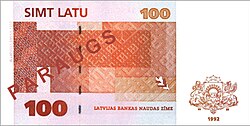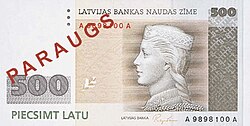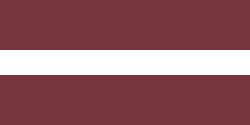Lats
| Lats | |
|---|---|
 1 Lats | |
| Staat: | |
| Unterteilung: | 100 Santīmu |
| ISO-4217-Code: | LVL |
| Abkürzung: | Ls |
| Wechselkurs: (fix) | 1 EUR = 0,702804 LVL |
Der Lats (Plural: Lati, Genitiv Plural: Latu (nach Zahlwörtern, die nicht gebeugt werden – desmit [10], simt [100], tūkstotis [1000] – steht der Gen. Pl.), 1 Lats = 100 Santīmu) war von 1922 bis zum 17. Juni 1940 sowie von Oktober 1993 bis zum 31. Dezember 2013 die Währung Lettlands. Er ist damit der Vorgänger der lettischen Euromünzen.
Geschichte



Der Lats wurde im Jahr 1922 als Goldwährung eingeführt. Als Übergangswährung vom russischen Rubel diente zuvor der Lettische Rubel (Latvijas rublis, Papierwährung), der dann im Verhältnis 50 Lettische Rubel zu 1 Lats umgetauscht wurde. Es gab Banknoten zu 10 Latu, auf 500 Rubli von 1920 gedruckt, sowie solche zu 20, 25, 50, 100 und 500 Latu, außerdem Staatsnoten zu 5 Lati und zu 10 und 20 Latu. Silbermünzen zu 1 Lats, 2 und 5 Lati sowie Kupfer- und Nickelmünzen. 1 Lats entsprach im Jahr 1928 einem Wert von 0,81 Goldmark (Reichsmark in Goldwährung).
Der Lats wurde im Zuge der Okkupation durch die Sowjetunion im Laufe des Jahres 1940 durch den sowjetischen Rubel ersetzt, dieser im Zuge der Okkupation durch das nationalsozialistische Deutschland durch die Reichsmark und diese nach der Reokkupation durch die Sowjets wieder durch den sowjetischen Rubel.
Nach der vollständigen Wiederherstellung der Unabhängigkeit der Republik Lettland im August 1991 wurde der sowjetische Rubel am 7. Mai 1992 zunächst vom Lettischen Rubel (Latvijas rublis, im Volksmund nach dem damaligen lettischen Finanzminister Einārs Repše auch Repšes rublis[1], repši, repsīši oder repšiki genannt) im Kurs von 1:1 abgelöst.[2] Den zweiten Schritt vollzog die lettische Nationalbank Latvijas Banka im Oktober 1993: den Umtausch in Lat zum Kurs von 200 Lettischen Rubeln zu 1 Lats. Damit hatte Lettland zeitweise die hochwertigste Währungseinheit Europas. Einārs Repše bestätigte 2003 eine entsprechende Anekdote über den Ursprung des Umtauschverhältnisses: Die Proportion sei so gewählt worden, damit man auch noch für 1 Santīms etwas Nützliches habe kaufen können, und eine Streichholzschachtel sei damals für 2 Lettische Rubel gehandelt worden.[3] Die Stabilität der Währung wurde seither durch die Deckung mit Devisen- und Goldreserven sowie Investitionen in einer Anzahl von verschiedenen ausländischen Währungen gewährleistet.
Zum 1. Januar 2014 wurde der Lats vom Euro als Landeswährung abgelöst.[4] Am 9. Juli 2013 segneten die Finanzminister der EU-Mitgliedstaaten den Beitritt Lettlands als 18. Euroland ab, ihre Staats- bzw. Regierungschefs taten dies bereits auf ihrem Gipfel Ende Juni 2013.[5] Der Wechselkurs wurde mit 0,702804 Lats je Euro bzw. 1 LVL = 1,422872 EUR festgelegt.

Wechselkursmechanismus II
Lettland trat am 1. Mai 2004 der EU bei. Seit dem 1. Januar 2005 war der Lats in Vorbereitung auf den Beitritt zum Euro über ein Currency Board mit einem gering schwankenden Wechselkurs (maximal 1 %) an den Euro gebunden. Im Jahr 2007 wich er aber öfter um mehr als 1 % vom Richtwert 0,696 LVL/EUR ab. Zuvor war der Lats an die Sonderziehungsrechte des Internationalen Währungsfonds (IWF) gebunden, einen Währungskorb, der hauptsächlich vom Dollarkurs beeinflusst wird, und konnte damit gegenüber dem Euro leicht schwanken. Am 29. April 2005 erfolgte zusammen mit Malta und Zypern der Beitritt zum Wechselkursmechanismus II.
Bargeld
Kursmünzen gab es in Stückelungen von 1 Lats und 2 Lati sowie 1 Santīms, 2, 5 Santīmi, 10, 20 und 50 Santīmu, Banknoten zu 5 Lati, 10, 20, 50, 100 und 500 Latu. Der 500-Latu-Schein war die sich im allgemeinen Umlauf befindende Banknote mit dem europaweit, nach dem 1000-Schweizer-Franken-Schein, zweithöchsten realen Gegenwert.
Kursmünzen
- 1 Santīms
- 2 Santīmi
- 5 Santīmi
- 10 Santīmu
- 20 Santīmu
- 50 Santīmu
- 1 Lats – Lachs (1992)
- 2 Lati (1992)
- 2 Lati (1999)
Sondermünzen
| Bild | Motiv | Ausgabedatum | Auflage |
|---|---|---|---|
 | Storch | 2001 | 250.000 |
 | Ameise | 2003 | 250.000 |
 | Pilz | 2004 | 500.000 |
 | Sprīdītis | 2004 | 500.000 |
 | Wetterhahn der Petrikirche[6] | 25. Mai 2005 | 500.000 |
 | Kringel[7] | 14. Dezember 2005 | 500.000 |
 | Johanni-Kranz aus Eichenlaub[8] | 15. Juni 2006 | 1.000.000 |
- weitere Sondermünzen
- 100-Latu-Goldmünze (1998)
- 1 Lats – Eishockey-WM 2006 (2005)
Banknoten
Mit dem Druck der ersten Serie wurde 1992 begonnen. Kleine Änderungen der Sicherheitsmerkmale bei nachfolgenden Jahrgängen sollten die Sicherheit der Banknoten gewährleisten. Die letzte Serie (20 Latu) wurde 2009 gedruckt.[9] Alle Banknoten waren 65 × 130 mm groß; das Seitenverhältnis 1:2 entsprach somit den Proportionen der Flagge der Republik Lettland.
| Notenwert | Farbe | Vorderseite | Rückseite |
|---|---|---|---|
| 5 Lati | grün |  Eiche Eiche |  geschnitztes Sonnenornament geschnitztes Sonnenornament |
| 10 Latu | violett |  Daugava Daugava |  traditionelle lettische Fibel traditionelle lettische Fibel |
| 20 Latu | braun |  traditioneller lettischer Bauernhof traditioneller lettischer Bauernhof |  traditionelle lettische Webornamente traditionelle lettische Webornamente |
| 50 Latu | blau |  Hansekogge Hansekogge |  Stadtwappen und -plan von Riga Stadtwappen und -plan von Riga |
| 100 Latu | rot |  Krišjānis Barons Krišjānis Barons |  Fragmente des Der Gürtel von Lielvārde Fragmente des Der Gürtel von Lielvārde |
| 500 Latu | golden |  lettisches Bauernmädchen lettisches Bauernmädchen |  Ornamente eines Bronzehutes Ornamente eines Bronzehutes |
Einzelnachweise
- ↑ Māris Gailis: Varas tehnoloģija. Jumava, Riga 1997, S. 65.
- ↑ Patstāvīga naudas sistēma Latvijā sākās ar Latvijas rubli, Interview (2007) mit Einārs Repše auf bank.lv, abgerufen am 29. Mai 2020.
- ↑ Lato Lapsa, Kristīne Jančevska: Mūsu Vēsture 1985–2005, Band 1, 2007, ISBN 978-9984-34-297-9, S. 421.
- ↑ EU-Finanzminister billigen Aufnahme: Lettland bekommt den Euro. auf: tagesschau.de, 9. Juli 2013, abgerufen am 9. Juli 2013.
- ↑ EU-Gipfel segnet Lettlands Euro-Beitritt ab. In: Der Standard. 28. Juni 2013, abgerufen am 29. Juni 2013.
- ↑ Par 1 lata monētas ar Pētergaiļa attēlu laišanu apgrozībā auf bank.lv, abgerufen am 29. Mai 2020.
- ↑ Par 1 lata monētas ar kliņģera attēlu laišanu apgrozībā auf bank.lv, abgerufen am 29. Mai 2020.
- ↑ Par 1 lata monētas ar Jāņu vainaga attēlu laišanu apgrozībā auf bank.lv, abgerufen am 29. Mai 2020.
- ↑ Latvijas Bankas papīra naudas zīmes (banknotes) auf bank.lv, abgerufen am 29. Mai 2020.
Weblinks
Auf dieser Seite verwendete Medien
Die Europaflagge besteht aus einem Kranz aus zwölf goldenen, fünfzackigen, sich nicht berührenden Sternen auf azurblauem Hintergrund.
Sie wurde 1955 vom Europarat als dessen Flagge eingeführt und erst 1986 von der Europäischen Gemeinschaft übernommen.
Die Zahl der Sterne, zwölf, ist traditionell das Symbol der Vollkommenheit, Vollständigkeit und Einheit. Nur rein zufällig stimmte sie zwischen der Adoption der Flagge durch die EG 1986 bis zur Erweiterung 1995 mit der Zahl der Mitgliedstaaten der EG überein und blieb daher auch danach unverändert.1 Lats Latvia - Stork
Obverse: The large coat of arms of the Republic of Latvia, with the year 2001 inscribed below, is placed in the centre. The inscriptions LATVIJAS and REPUBLIKA, each arranged in a semicircle, are above and beneath the central motif, respectively.
Reverse: A nesting stork is featured in the upper part of the coin. The numeral 1, with the inscription LATS in a semicircle beneath it, is centred in the lower part.
Edge: Two inscriptions LATVIJAS BANKA (Bank of Latvia), separated by rhombic dots.1 Lats Latvia - Ligo night celebrant
Obverse: The large coat of arms of the Republic of Latvia, with the year 2006 inscribed below, is placed in the centre. The inscriptions LATVIJAS and REPUBLIKA, each arranged in a semicircle, are above and beneath the central motif, respectively.
Reverse: A profile of Ligo night (summer solstice) celebrant adorned with a wreath is featured in the upper part of the coin. The numeral 1, with the inscription LATS in a semicircle, is arranged in the lower part.
Edge: Two inscriptions LATVIJAS BANKA (Bank of Latvia), separated by rhombic dots.50 Santimu Latvia
Obverse: The small coat of arms of the Republic of Latvia, encircled by the inscription LATVIJAS REPUBLIKA • 1992 (Republic of Latvia 1992), is placed in the centre.
Reverse: A pine tree seedling, the symbol of bountiful Latvian timber resources, is depicted in the upper part of the coin. A horizontal line separates it from the numeral 50, under which the inscription SANTIMU is placed in a semicircle.
5 Santimi Latvia
Obverse: The small coat of arms of the Republic of Latvia, encircled by the inscription LATVIJAS REPUBLIKA • 1992 or LATVIJAS REPUBLIKA • 2006 (Republic of Latvia 1992 or Republic of Latvia 2006), is placed in the centre.
Reverse: The numeral 5 is centered on the coin. The inscription SANTIMI, arranged in a semicircle, is beneath the numeral 5. Above the numeral, five arcs join two diamond-shaped suns which are located on either side of the numeral 5.
1 Lats Latvia - Spriditis
Obverse: The large coat of arms of the Republic of Latvia with the year 2004 inscribed below it is in the center. The inscriptions LATVIJAS and REPUBLIKA, each arranged in a semicircle, are above and beneath the central motif, respectively.
Reverse: Sprīdītis, a fairytale character, is featured in the upper part of the coin. 10 stars are arranged in a semicircle around the central motif, and the inscription Latvija – ES 2004 is beneath it. The numeral 1 is situated in the lower part of the coin, and the inscription LATS is arranged in a semicircle beneath it.
Edge: Two inscriptions LATVIJAS BANKA (Bank of Latvia), separated by rhombic dots.Autor/Urheber: Latvijas Banka, Lizenz: Latvian banknote
500 Lati averss
Reverse of five lats coins issued in 1931. See Image:Five Latvian Lats 1931.jpg for detalised description of the coin
1 Lats Latvia - Salmon
Obverse: The large coat of arms of the Republic of Latvia, with the year 1992 inscribed below, is placed in the centre. The inscriptions LATVIJAS and REPUBLIKA, each arranged in a semicircle, are above and beneath the central motif, respectively.
Reverse: A salmon, the symbol of Latvia's abundant water resources, is shown jumping out of the water from left to right. The numeral 1, with the inscription LATS in a semicircle beneath it, is centered in the lower part of the coin.
Edge: Two inscriptions LATVIJAS BANKA (Bank of Latvia), separated by rhombic dots.1 Lats Latvia - Mushroom
Obverse: The large coat of arms of the Republic of Latvia with the year 2004 inscribed below it is in the center. The inscriptions LATVIJAS and REPUBLIKA, each arranged in a semicircle, are above and beneath the central motif, respectively.
Reverse: A mushroom is featured in the upper part of the coin. The numeral 1 is beneath it, a line stretches from the center to the right, and the inscription LATS is situated in the lower part of the coin.
Edge: Two inscriptions LATVIJAS BANKA (Bank of Latvia), separated by rhombic dots.1 Lats Latvia - Ant Obverse: The large coat of arms of the Republic of Latvia, with the year 2003 inscribed below, is placed in the centre. The inscriptions LATVIJAS and REPUBLIKA, each arranged in a semicircle, are above and beneath the central motif, respectively. Reverse: An ant is featured in the upper part of the coin. The numeral 1, with the inscription LATS in a semicircle beneath it, is centred in the lower part.
Edge: Two inscriptions LATVIJAS BANKA (Bank of Latvia), separated by rhombic dots.20 Santimu Latvia
Obverse: The small coat of arms of the Republic of Latvia, encircled by the inscription LATVIJAS REPUBLIKA • 1992 (Republic of Latvia 1992), is placed in the centre.
Reverse: The numeral 20 is centered on the coin. The inscription SANTIMU, arranged in a semicircle, is beneath the numeral 20. Above the numeral, five arcs join two diamond-shaped suns which are located on either side of the numeral 20.
Edge: plain.2 Lati Latvia 1999
Obverse: The large coat of arms of the Republic of Latvia is placed in the central circle. The inscriptions LATVIJAS REPUBLIKA and 1999, each arranged in a semicircle and separated by two dots, are in the outer ring respectively above and beneath the central motif.
Reverse: The upper part of the central circle features a cow, with the figure 2 directly beneath. The inscription LATI is arranged in the bottom part of the outer ring. The background motif (clouds and grass) links the central circle with the outer ring.
Edge: Reeded; two inscriptions LATVIJAS BANKA (Bank of Latvia), separated by dots.10 Santimu Latvia
Obverse: The small coat of arms of the Republic of Latvia, encircled by the inscription LATVIJAS REPUBLIKA • 1992 (Republic of Latvia 1992), is placed in the centre.
Reverse: The numeral 10 is centered on the coin. The inscription SANTIMU, arranged in a semicircle, is beneath the numeral 10. Above the numeral, five arcs join two diamond-shaped suns which are located on either side of the numeral 10.
Edge: plain.Ice Hockey World Championship 2006 - 1 Lats (2005)
Weight: 31.47 g; diameter: 38.61 mm
Metal: silver, fineness .925; quality: proof
Artists: Artis Rutks (graphic design), Ligita Franckevica (plaster model)
Obverse: The obverse of the coin features the large coat of arms of the Republic of Latvia in the central field, with the year 2005 beneath it. The inscription LATVIJAS REPUBLIKA is arranged in a semicircle above the central motif. The numeral 1 with a semi-circled inscription LATS below are placed at the lower part of the coin.
Reverse: A puck is placed in the central field of the reverse, with two horizontal inscriptions RIGA 2006 on either side. Of the two views of this inscription, the one on the right is presented in inverted lettering. The top and the bottom of the reverse feature images of two hockey players viewed from above. The inscriptions Pasaules cempionats hokeja and Ice Hockey World Championship, each arranged in a semicircle, are on both sides of the central motif.
2 Santimi Latvia
Obverse: The small coat of arms of the Republic of Latvia, encircled by the inscription LATVIJAS REPUBLIKA • 1992, LATVIJAS REPUBLIKA • 2000 or LATVIJAS REPUBLIKA • 2006 (Republic of Latvia 1992, 2000 or 2006), is placed in the centre.
Reverse: The numeral 2 is centered on the coin. The inscription SANTIMI, arranged in a semicircle, is beneath the numeral 2. Above the numeral, five arcs join two diamond-shaped suns which are located on either side of the numeral 2.
Edge: plain.1 Lats Latvia - Cock
Obverse: The large coat of arms of the Republic of Latvia, with the year 2005 inscribed below, is placed in the centre. The inscriptions LATVIJAS and REPUBLIKA, each arranged in a semicircle, are above and beneath the central motif, respectively.
Reverse: The cock on the spire of St. Peter's church in Riga is featured in the upper part of the coin. The numeral 1, with the inscription LATS in a semicircle on the right, is arranged in the lower part.
Edge: Two inscriptions LATVIJAS BANKA (Bank of Latvia), separated by rhombic dots.1 Lats Latvia - Pretzel
Obverse: The large coat of arms of the Republic of Latvia, with the year 2005 inscribed below, is placed in the centre. The inscriptions LATVIJAS and REPUBLIKA, each arranged in a semicircle, are above and beneath the central motif, respectively.
Reverse: A pretzel is featured in the upper part of the coin. The numeral 1, with the inscription LATS in a semicircle, is arranged in the lower part.
Edge: Two inscriptions LATVIJAS BANKA (Bank of Latvia), separated by rhombic dots.1 Santims Latvia
Obverse: The small coat of arms of the Republic of Latvia, encircled by the inscription LATVIJAS REPUBLIKA • 1992, LATVIJAS REPUBLIKA • 1997, LATVIJAS REPUBLIKA • 2003 or LATVIJAS REPUBLIKA • 2005 (Republic of Latvia 1992, 1997, 2003 or 2005), is placed in the centre.
Reverse: The numeral 1 is centered on the coin. The inscription SANTIMS, arranged in a semicircle, is beneath the numeral 1. Above the numeral, five arcs join two diamond-shaped suns which are located on either side of the numeral 1.
Edge: plain.2 Lati Latvia 1992
Obverse: The large coat of arms of the Republic of Latvia, with the year 1992 inscribed below, is placed in the centre. The inscriptions LATVIJAS and REPUBLIKA, each arranged in a semicircle, are above and beneath the central motif, respectively.
Reverse: A grazing cow, depicted in the upper part of the coin, is a symbol of the wealth of the Latvian countryside. The numeral 2, with the inscription LATI in a semicircle beneath it, is centered in the lower part of the coin.
Edge: Two inscriptions LATVIJAS BANKA (Bank of Latvia), separated by rhombic dots.100 Lats Gold Coin Latvia - Open Circle
- Obverse: The large coat of arms of the Republic of Latvia, with the year 1998 inscribed below, is placed in the centre. The inscriptions LATVIJAS and REPUBLIKA, each arranged in a semicircle, are above and beneath the central motif, respectively.
- Reverse: The numeral 100, intertwined with an open circle symbolizing development, is figured in the centre. The inscription LATU, arranged in a semicircle, is placed in the lower part. The coin's weight and the fineness of the metal (16.2 g Au .999) are also indicated in the lower part.
- Edge: Three reeded and smooth segments are alternated.
Autor/Urheber: HJunghans, Lizenz: CC BY-SA 4.0
1 Santims Lettland 1935 Wappenseite
Autor/Urheber: Latvijas Banka, Lizenz: Latvian banknote
500 Lati reverss
Autor/Urheber: Latvijas Banka, Lizenz: Latvian banknote
100 Lati averss














































